Analysis of the Chaotic Component of Photoplethysmography and Its Association with Hemodynamic Parameters
Abstract
:1. Introduction
2. Materials and Methods
2.1. Data Collection and Preprosessing
- Pulse pressure was smaller than 15 mmHg.
- The correlation coefficient of BP and the PPG waveform was less than 0.8 [24].
- Peak-to-peak distance of one “cardiac cycle” exceeded 1.5 s or was less than 0.5 s.
2.2. Brief Introduction of the WK4 Model
2.3. Hemodynamic Parameter Estimation
2.4. Morphological Features of PPG
2.5. Complexity Measures of PPG Signals
2.5.1. Separating Fractal and Oscillatory Components
2.5.2. Calculation of Fractal Dimensions
2.5.3. Entropy Measures
- Sample Entropy (SampEn): SampEn was used to quantify the irregularity or unpredictability of the time series data. It assessed the complexity of a signal by measuring the likelihood of finding repeated patterns within a specified length [45].
- Approximate Entropy (ApEn): Similar to SampEn, ApEn measured the amount of unpredictability in the time series data, with higher values indicating greater complexity [46].
- Fuzzy Entropy (FuzzEn): FuzzEn is a measure of complexity that incorporates uncertainty or fuzziness in data by using fuzzy sets. It quantified the disorder or complexity in systems with imprecise or uncertain information [47].
2.6. Causal Relationship between Hemodynamics and Complexity Measures
2.7. Statistical Tests
3. Results and Discussions
3.1. Hemodynamics Characteristics
3.2. Quantification of the Chaotic Component of PPG Signals
3.3. Correlation of PPG Complexities and Hemodynamic Status
3.4. Sensitivity of Complexity Measures to Hemodynamics
3.5. Granger’s Causality Test
3.6. Potential Improvement by Adding Temporal Complexity Information
4. Discussion
4.1. Novelty of the Study
- (1)
- Multiscale fractal components’ power increased with declining vascular compliance, indicating their significance in individuals with stiff blood vessels.
- (2)
- The HFD and KFD had the strongest correlation with SBP and DBP, respectively, compared to other complexity measures.
- (3)
- The sensitivity of the FD to BP was more pronounced in individuals with higher hemodynamic instability.
- (4)
- The Granger causality showed that both feedback and unidirectional relationships exist between hemodynamics and HFD, while HRV was the influencer rather than being influenced. The KFD may be more relevant to vascular structural complexities.
- (5)
- Subjects with clear causal feedback between HFD and hemodynamics exhibited significantly increased fluctuations in cardiac output.
- (6)
- Healthy subjects displayed a greater occurrence of fractal components, which should be taken into consideration when estimating hemodynamic parameters. Additionally, less invasive surgeries, particularly those that do not significantly affect the cardiovascular system, showed a relatively stronger complexity–hemodynamics correlation.
4.2. Comparison with Previous Studies
4.3. Limitations of the Study
4.4. Suggestions for Future Work
5. Conclusions
Supplementary Materials
Author Contributions
Funding
Institutional Review Board Statement
Data Availability Statement
Acknowledgments
Conflicts of Interest
References
- Elgendi, M.; Fletcher, R.; Liang, Y.; Howard, N.; Lovell, N.H.; Abbott, D.; Lim, K.; Ward, R. The use of photoplethysmography for assessing hypertension. npj Digit. Med. 2019, 2, 60. [Google Scholar] [CrossRef] [PubMed]
- Radha, M.; de Groot, K.; Rajani, N.; Wong, C.C.P.; Kobold, N.; Vos, V.; Fonseca, P.; Mastellos, N.; Wark, P.A.; Velthoven, N.; et al. Estimating blood pressure trends and the nocturnal dip from photoplethysmography. Physiol. Meas. 2019, 40, 025006. [Google Scholar] [CrossRef] [PubMed]
- Cosoli, G.; Spinsante, S.; Scalise, L. Wrist-worn and chest-strap wearable devices: Systematic review on accuracy and metrological characteristics. Measurement 2020, 159, 107789. [Google Scholar] [CrossRef]
- Zhang, M.; Qiu, L.; Chen, Y.; Yang, S.; Zhang, Z.; Wang, L. A Conv-Transformer network for heart rate estimation using ballistocardiographic signals. Biomed. Signal Process. Control 2023, 80, 104302. [Google Scholar] [CrossRef]
- Christ, F.; Abicht, J.M.; Athelogou, M.; Baschnegger, H.; Niklas, M.; Peter, K.; Messmer, K. Cardiovascular monitoring of elective aortic aneurysm repair using methods of chaos analysis. Int. J. Microcirc. Clin. Exp. 1997, 17, 374–384. [Google Scholar] [CrossRef]
- Khodabakhshi, M.B.; Eslamyeh, N.; Sadredini, S.Z.; Ghamari, M. Cuffless blood pressure estimation using chaotic features of photoplethysmograms and parallel convolutional neural network. Comput. Methods Programs Biomed. 2022, 226, 107131. [Google Scholar] [CrossRef]
- Prabhakar, S.K.; Rajaguru, H.; Kim, S.H. Fuzzy-Inspired Photoplethysmography Signal Classification with Bio-Inspired Optimization for Analyzing Cardiovascular Disorders. Diagnostics 2020, 10, 763. [Google Scholar] [CrossRef]
- Mc, M.D.; Chong, J.W.; Soni, A.; Saczynski, J.S.; Esa, N.; Napolitano, C.; Darling, C.E.; Boyer, E.; Rosen, R.K.; Floyd, K.C.; et al. PULSE-SMART: Pulse-Based Arrhythmia Discrimination Using a Novel Smartphone Application. J. Cardiovasc. Electrophysiol. 2016, 27, 51–57. [Google Scholar] [CrossRef]
- Chen, W.; Jiang, F.; Chen, X.; Feng, Y.; Miao, J.; Chen, S.; Jiao, C.; Chen, H. Photoplethysmography-derived approximate entropy and sample entropy as measures of analgesia depth during propofol-remifentanil anesthesia. J. Clin. Monit. Comput. 2021, 35, 297–305. [Google Scholar] [CrossRef]
- Rantanen, M.; Yli-Hankala, A.; van Gils, M.; Yppärilä-Wolters, H.; Takala, P.; Huiku, M.; Kymäläinen, M.; Seitsonen, E.; Korhonen, I. Novel multiparameter approach for measurement of nociception at skin incision during general anaesthesia. Br. J. Anaesth. 2006, 96, 367–376. [Google Scholar] [CrossRef]
- Wei, H.-C.; Xiao, M.-X.; Ta, N.; Wu, H.-T.; Sun, C.-K. Assessment of Diabetic Autonomic Nervous Dysfunction with a Novel Percussion Entropy Approach. Complexity 2019, 2019, 6469853. [Google Scholar] [CrossRef]
- Maciorowska, M.; Krzesiński, P.; Wierzbowski, R.; Uziębło-Życzkowska, B.; Gielerak, G. Associations between Heart Rate Variability Parameters and Hemodynamic Profiles in Patients with Primary Arterial Hypertension, Including Antihypertensive Treatment Effects. J. Clin. Med. 2022, 11, 3767. [Google Scholar] [CrossRef] [PubMed]
- Task Force of the European Society of Cardiology and the North American Society of Pacing and Electrophysiology. Heart rate variability: Standards of measurement, physiological interpretation and clinical use. Circulation 1996, 93, 1043–1065. [Google Scholar] [CrossRef]
- Schroeder, E.B.; Liao, D.; Chambless, L.E.; Prineas, R.J.; Evans, G.W.; Heiss, G. Hypertension, Blood Pressure, and Heart Rate Variability. Hypertension 2003, 42, 1106–1111. [Google Scholar] [CrossRef] [PubMed]
- Sviridova, N.; Sakai, K. Human photoplethysmogram: New insight into chaotic characteristics. Chaos Solitons Fractals 2015, 77, 53–63. [Google Scholar] [CrossRef]
- Sviridova, N.; Zhao, T.; Aihara, K.; Nakamura, K.; Nakano, A. Photoplethysmogram at green light: Where does chaos arise from? Chaos Solitons Fractals 2018, 116, 157–165. [Google Scholar] [CrossRef]
- Xing, X.; Ma, Z.; Zhang, M.; Gao, X.; Li, Y.; Song, M.; Dong, W.F. Robust blood pressure estimation from finger photoplethysmography using age-dependent linear models. Physiol. Meas. 2020, 41, 025007. [Google Scholar] [CrossRef]
- Xing, X.; Huang, R.; Hao, L.; Jiang, C.; Dong, W.-F. Temporal complexity in photoplethysmography and its influence on blood pressure. Front. Physiol. 2023, 14, 1187561. [Google Scholar] [CrossRef]
- Lee, H.-C.; Park, Y.; Yoon, S.B.; Yang, S.M.; Park, D.; Jung, C.-W. VitalDB, a high-fidelity multi-parameter vital signs database in surgical patients. Sci. Data 2022, 9, 279. [Google Scholar] [CrossRef]
- Carlson, C.; Turpin, V.R.; Suliman, A.; Ade, C.; Warren, S.; Thompson, D.E. Bed-Based Ballistocardiography: Dataset and Ability to Track Cardiovascular Parameters. Sensors 2020, 21, 156. [Google Scholar] [CrossRef]
- Shin, H.S.; Lee, C.; Lee, M. Adaptive threshold method for the peak detection of photoplethysmographic waveform. Comput. Biol. Med. 2009, 39, 1145–1152. [Google Scholar] [CrossRef] [PubMed]
- Fine, J.; Branan, K.L.; Rodriguez, A.J.; Boonya-ananta, T.; Ajmal; Ramella-Roman, J.C.; McShane, M.J.; Coté, G.L. Sources of Inaccuracy in Photoplethysmography for Continuous Cardiovascular Monitoring. Biosensors 2021, 11, 126. [Google Scholar] [CrossRef] [PubMed]
- Ignácz, A.; Földi, S.; Sótonyi, P.; Cserey, G. NB-SQI: A novel non-binary signal quality index for continuous blood pressure waveforms. Biomed. Signal Process. Control 2021, 70, 103035. [Google Scholar] [CrossRef]
- Xing, X.; Sun, M. Optical blood pressure estimation with photoplethysmography and FFT-based neural networks. Biomed. Opt. Express 2016, 7, 3007–3020. [Google Scholar] [CrossRef] [PubMed]
- Wang, W.; Mohseni, P.; Kilgore, K.L.; Najafizadeh, L. PulseDB: A large, cleaned dataset based on MIMIC-III and VitalDB for benchmarking cuff-less blood pressure estimation methods. Front. Digit. Health 2023, 4, 1090854. [Google Scholar] [CrossRef]
- Elgendi, M. Optimal Signal Quality Index for Photoplethysmogram Signals. Bioengineering 2016, 3, 21. [Google Scholar] [CrossRef]
- Wang, L.; Xu, L.; Zhou, S.; Wang, H.; Yao, Y.; Hao, L.; Li, B.N.; Qi, L. Design and implementation of a pulse wave generator based on Windkessel model using field programmable gate array technology. Biomed. Signal Process. Control 2017, 36, 93–101. [Google Scholar] [CrossRef]
- Westerhof, N.; Stergiopulos, N.; Noble, M.I.M. Snapshots of Hemodynamics; Springer: Berlin/Heidelberg, Germany, 2010. [Google Scholar]
- Westerhof, N.; Lankhaar, J.-W.; Westerhof, B.E. The arterial Windkessel. Med. Biol. Eng. Comput. 2009, 47, 131–141. [Google Scholar] [CrossRef]
- Allen, J.; Murray, A. Modelling the relationship between peripheral blood pressure and blood volume pulses using linear and neural network system identification techniques. Physiol. Meas. 1999, 20, 287–301. [Google Scholar] [CrossRef]
- Xing, X.; Ma, Z.; Xu, S.; Zhang, M.; Zhao, W.; Song, M.; Dong, W.-F. Blood pressure assessment with in-ear photoplethysmography. Physiol. Meas. 2021, 42, 105009. [Google Scholar] [CrossRef]
- Segers, P.; Rietzschel, E.R.; De Buyzere, M.L.; Stergiopulos, N.; Westerhof, N.; Van Bortel, L.M.; Gillebert, T.; Verdonck, P.R. Three- and four-element Windkessel models: Assessment of their fitting performance in a large cohort of healthy middle-aged individuals. Proc. Inst. Mech. Eng. H 2008, 222, 417–428. [Google Scholar] [CrossRef] [PubMed]
- Elgendi, M. On the analysis of fingertip photoplethysmogram signals. Curr. Cardiol. Rev. 2012, 8, 14–25. [Google Scholar] [CrossRef] [PubMed]
- Awad, A.A.; Stout, R.G.; Ghobashy, M.A.; Rezkanna, H.A.; Silverman, D.G.; Shelley, K.H. Analysis of the ear pulse oximeter waveform. J. Clin. Monit. Comput. 2006, 20, 175–184. [Google Scholar] [CrossRef]
- Sun, S.; Bezemer, R.; Long, X.; Muehlsteff, J.; Aarts, R.M. Systolic blood pressure estimation using PPG and ECG during physical exercise. Physiol. Meas. 2016, 37, 2154–2169. [Google Scholar] [CrossRef] [PubMed]
- Zahedi, E.; Chellappan, K.; Ali, M.A.; Singh, H. Analysis of the effect of ageing on rising edge characteristics of the photoplethysmogram using a modified Windkessel model. Cardiovasc. Eng. 2007, 7, 172–181. [Google Scholar] [CrossRef] [PubMed]
- Hashimoto, J.; Chonan, K.; Aoki, Y.; Nishimura, T.; Ohkubo, T.; Hozawa, A.; Suzuki, M.; Matsubara, M.; Michimata, M.; Araki, T.; et al. Pulse wave velocity and the second derivative of the finger photoplethysmogram in treated hypertensive patients: Their relationship and associating factors. J. Hypertens. 2002, 20, 2415–2422. [Google Scholar] [CrossRef] [PubMed]
- Wen, H.; Liu, Z. Separating Fractal and Oscillatory Components in the Power Spectrum of Neurophysiological Signal. Brain Topogr. 2016, 29, 13–26. [Google Scholar] [CrossRef]
- He, B.J.; Zempel, J.M.; Snyder, A.Z.; Raichle, M.E. The Temporal Structures and Functional Significance of Scale-free Brain Activity. Neuron 2010, 66, 353–369. [Google Scholar] [CrossRef]
- Lau, Z.J.; Pham, T.; Chen, S.H.A.; Makowski, D. Brain entropy, fractal dimensions and predictability: A review of complexity measures for EEG in healthy and neuropsychiatric populations. Eur. J. Neurosci. 2022, 56, 5047–5069. [Google Scholar] [CrossRef]
- Kesić, S.; Spasić, S.Z. Application of Higuchi’s fractal dimension from basic to clinical neurophysiology: A review. Comput. Methods Programs Biomed. 2016, 133, 55–70. [Google Scholar] [CrossRef]
- Katz, M.J. Fractals and the analysis of waveforms. Comput. Biol. Med. 1988, 18, 145–156. [Google Scholar] [CrossRef] [PubMed]
- Raghavendra, B.S.; Narayana Dutt, D. A note on fractal dimensions of biomedical waveforms. Comput. Biol. Med. 2009, 39, 1006–1012. [Google Scholar] [CrossRef] [PubMed]
- Rhodes, C.; Morari, M. The false nearest neighbors algorithm: An overview. Comput. Chem. Eng. 1997, 21, S1149–S1154. [Google Scholar] [CrossRef]
- Richman, J.S.; Lake, D.E.; Moorman, J.R. Sample Entropy. In Methods in Enzymology; Academic Press: Cambridge, MA, USA, 2004; Volume 384, pp. 172–184. [Google Scholar]
- Pincus, S. Approximate entropy (ApEn) as a complexity measure. Chaos 1995, 5, 110–117. [Google Scholar] [CrossRef] [PubMed]
- Al-Sharhan, S.; Karray, F.; Gueaieb, W.; Basir, O. Fuzzy Entropy: A Brief Survey. In Proceedings of the 10th IEEE International Conference on Fuzzy Systems (Cat. No.01CH37297), Melbourne, VIC, Australia, 2–5 December 2001; Volume 3, pp. 1135–1139. [Google Scholar]
- Ouyang, G.; Zhu, X.; Ju, Z.; Liu, H. Dynamical characteristics of surface EMG signals of hand grasps via recurrence plot. IEEE J. Biomed. Health Inform. 2014, 18, 257–265. [Google Scholar] [CrossRef]
- Ouyang, G.; Li, X.; Dang, C.; Richards, D.A. Using recurrence plot for determinism analysis of EEG recordings in genetic absence epilepsy rats. Clin. Neurophysiol. 2008, 119, 1747–1755. [Google Scholar] [CrossRef]
- Granger, C.W.J. Investigating causal relations by econometric models and cross-spectral methods. Econom. J. Econom. Soc. 1969, 37, 424–438. [Google Scholar]
- Le, T.-T.; Tan, R.S.; De Deyn, M.; Goh, E.P.C.; Han, Y.; Leong, B.R.; Cook, S.A.; Chin, C.W.-L. Cardiovascular magnetic resonance reference ranges for the heart and aorta in Chinese at 3T. J. Cardiovasc. Magn. Reson. 2016, 18, 21. [Google Scholar] [CrossRef]
- McVeigh, G.E.; Bratteli, C.W.; Morgan, D.J.; Alinder, C.M.; Glasser, S.P.; Finkelstein, S.M.; Cohn, J.N. Age-related abnormalities in arterial compliance identified by pressure pulse contour analysis: Aging and arterial compliance. Hypertension 1999, 33, 1392–1398. [Google Scholar] [CrossRef]
- Charlton, P.H.; Harana, J.M.; Vennin, S.; Li, Y.; Chowienczyk, P.; Alastruey, J. Modeling arterial pulse waves in healthy aging: A database for in silico evaluation of hemodynamics and pulse wave indexes. Am. J. Physiol.-Heart Circ. Physiol. 2019, 317, H1062–H1085. [Google Scholar] [CrossRef]
- Li, X. Association of age and blood pressure among 3.3 million adults: Insights from China PEACE million persons project. J. Hypertens. 2021, 39, 1143–1154. [Google Scholar] [CrossRef]
- Seber, G.A.F.; Wild, C.J. Nonlinear Regression; Wiley: Hoboken, NJ, USA, 1989. [Google Scholar]
- Fleischhauer, V.; Feldheiser, A.; Zaunseder, S. Beat-to-Beat Blood Pressure Estimation by Photoplethysmography and Its Interpretation. Sensors 2022, 22, 7037. [Google Scholar] [CrossRef]
- Harfiya, L.N.; Chang, C.-C.; Li, Y.-H. Continuous Blood Pressure Estimation Using Exclusively Photopletysmography by LSTM-Based Signal-to-Signal Translation. Sensors 2021, 21, 2952. [Google Scholar] [CrossRef] [PubMed]
- Wang, D.; Yang, X.; Liu, X.; Ma, L.; Li, L.; Wang, W. Photoplethysmography-Based Blood Pressure Estimation Combining Filter-Wrapper Collaborated Feature Selection With LASSO-LSTM Model. IEEE Trans. Instrum. Meas. 2021, 70, 4006914. [Google Scholar] [CrossRef]
- Slapničar, G.; Mlakar, N.; Luštrek, M. Blood Pressure Estimation from Photoplethysmogram Using a Spectro-Temporal Deep Neural Network. Sensors 2019, 19, 3420. [Google Scholar] [CrossRef] [PubMed]
- Ali, N.F.; Atef, M. LSTM Multi-Stage Transfer Learning for Blood Pressure Estimation Using Photoplethysmography. Electronics 2022, 11, 3749. [Google Scholar] [CrossRef]
- Meng, Z.; Yang, X.; Liu, X.; Wang, D.; Han, X. Non-invasive blood pressure estimation combining deep neural networks with pre-training and partial fine-tuning. Physiol. Meas. 2022, 43, 11NT01. [Google Scholar] [CrossRef] [PubMed]
- Hosanee, M.; Chan, G.; Welykholowa, K.; Cooper, R.; Kyriacou, P.A.; Zheng, D.; Allen, J.; Abbott, D.; Menon, C.; Lovell, N.H.; et al. Cuffless Single-Site Photoplethysmography for Blood Pressure Monitoring. J. Clin. Med. 2020, 9, 723. [Google Scholar] [CrossRef]
- Colovini, T.; Facciuto, F.; Cabral, M.E.; Parodi, R.; Spengler, M.I.; Piskorz, D. Application of Higuchi’s algorithm in central blood pressure pulse waves and its potential association with hemodynamic parameters in hypertensive patients. J. Hypertens. 2019, 37, e234. [Google Scholar] [CrossRef]
- Gomes, R.; Vanderlei, L.; Garner, D.; Vanderlei, F.; Valenti, V. Higuchi Fractal Analysis of Heart Rate Variability is Sensitive during Recovery from Exercise in Physically Active Men. Med. Express 2017, 4, M170302. [Google Scholar] [CrossRef]
- Mejía-Mejía, E.; Budidha, K.; Abay, T.Y.; May, J.M.; Kyriacou, P.A. Heart Rate Variability (HRV) and Pulse Rate Variability (PRV) for the Assessment of Autonomic Responses. Front. Physiol. 2020, 11, 779. [Google Scholar] [CrossRef] [PubMed]
- Mejía-Mejía, E.; May, J.M.; Torres, R.; Kyriacou, P.A. Pulse rate variability in cardiovascular health: A review on its applications and relationship with heart rate variability. Physiol. Meas. 2020, 41, 07tr01. [Google Scholar] [CrossRef] [PubMed]
- Mejía-Mejía, E.; Budidha, K.; Kyriacou, P.A.; Mamouei, M. Comparison of pulse rate variability and morphological features of photoplethysmograms in estimation of blood pressure. Biomed. Signal Process. Control 2022, 78, 103968. [Google Scholar] [CrossRef]

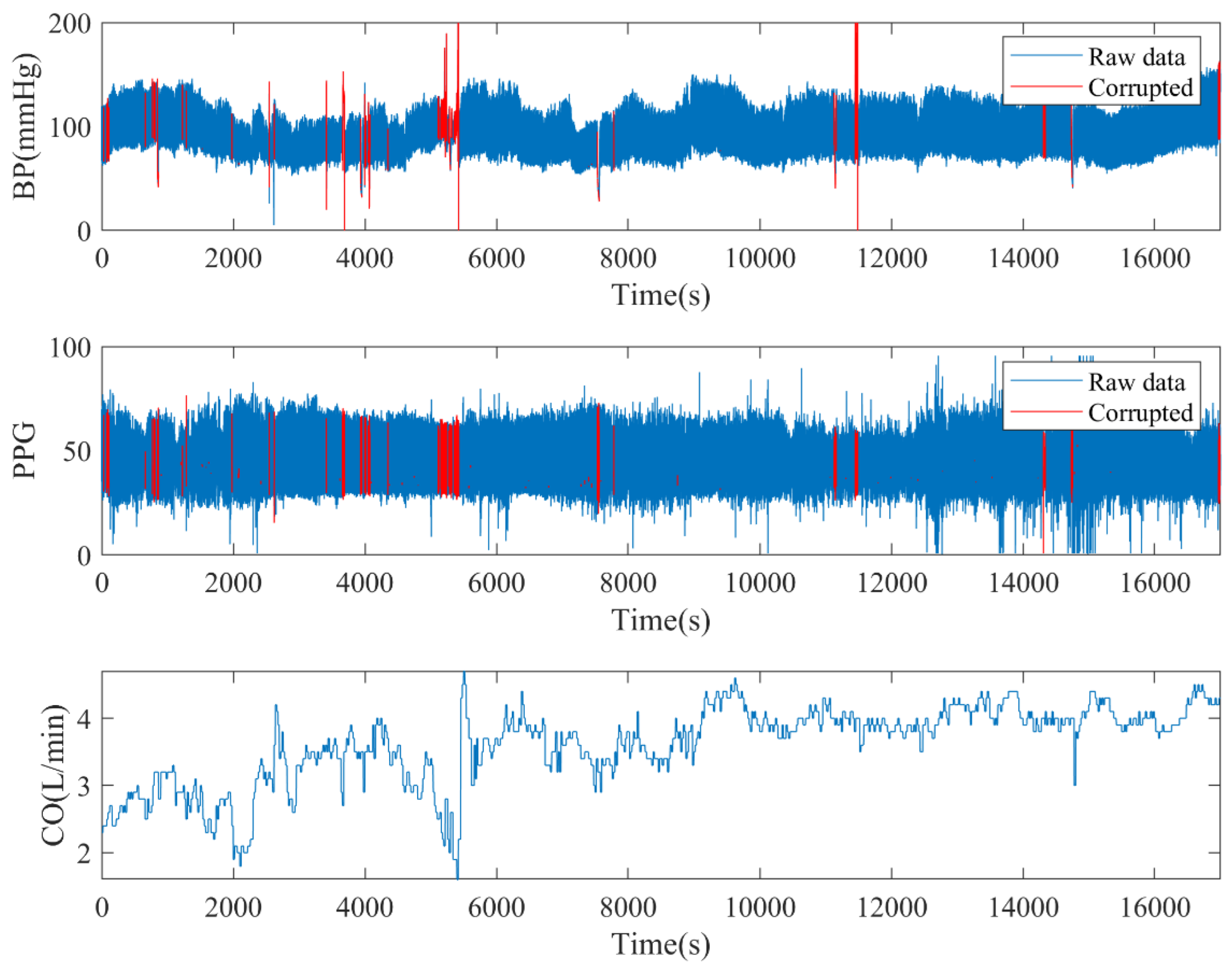


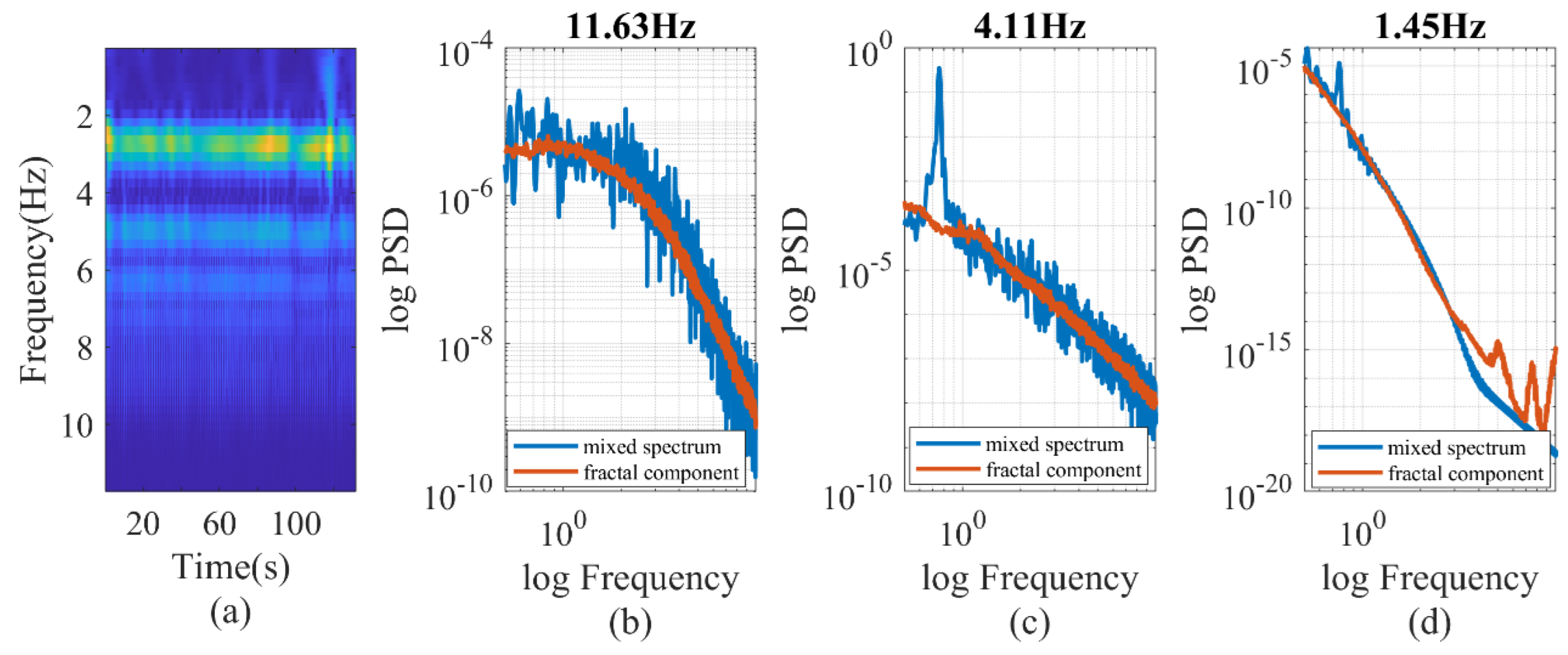
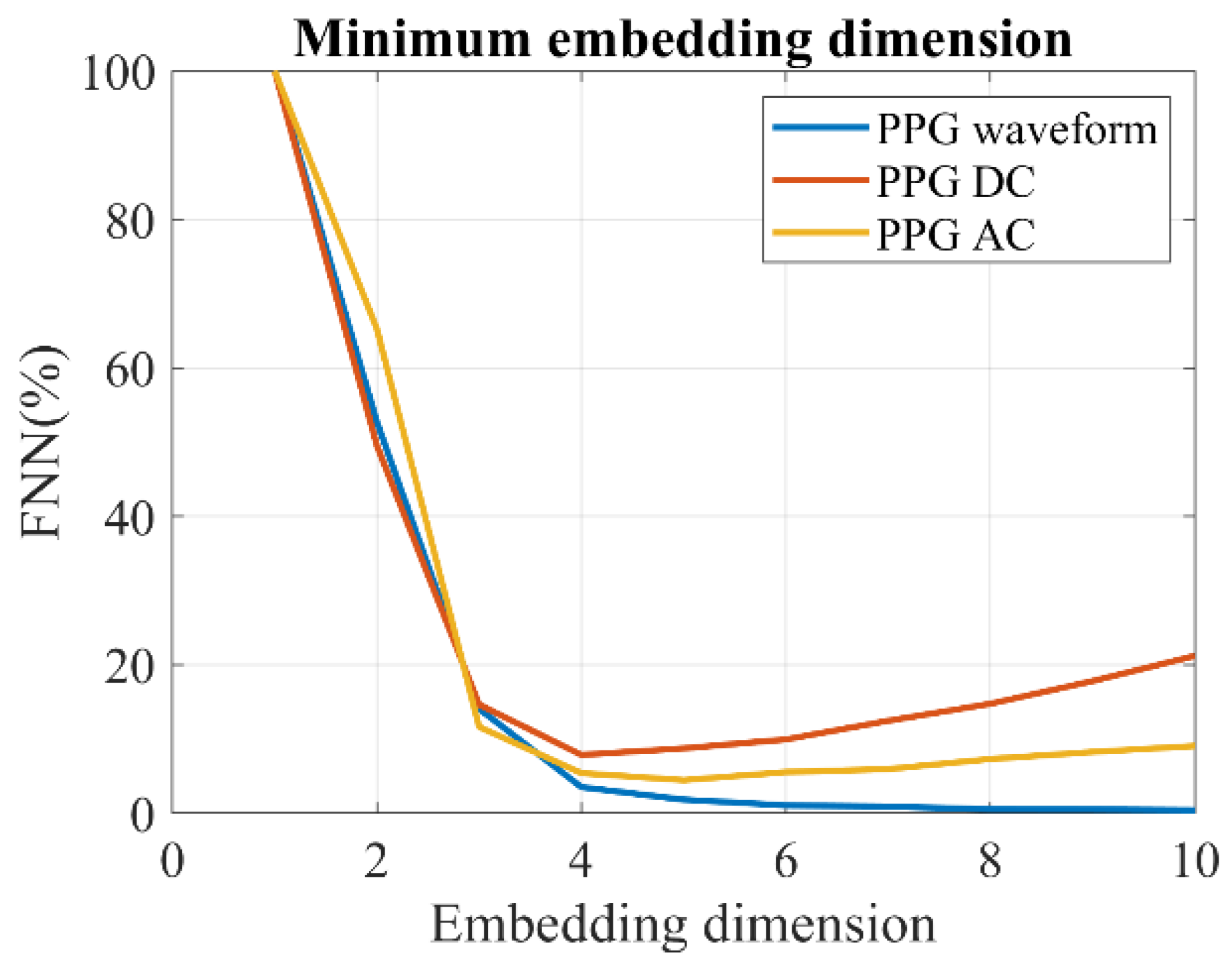
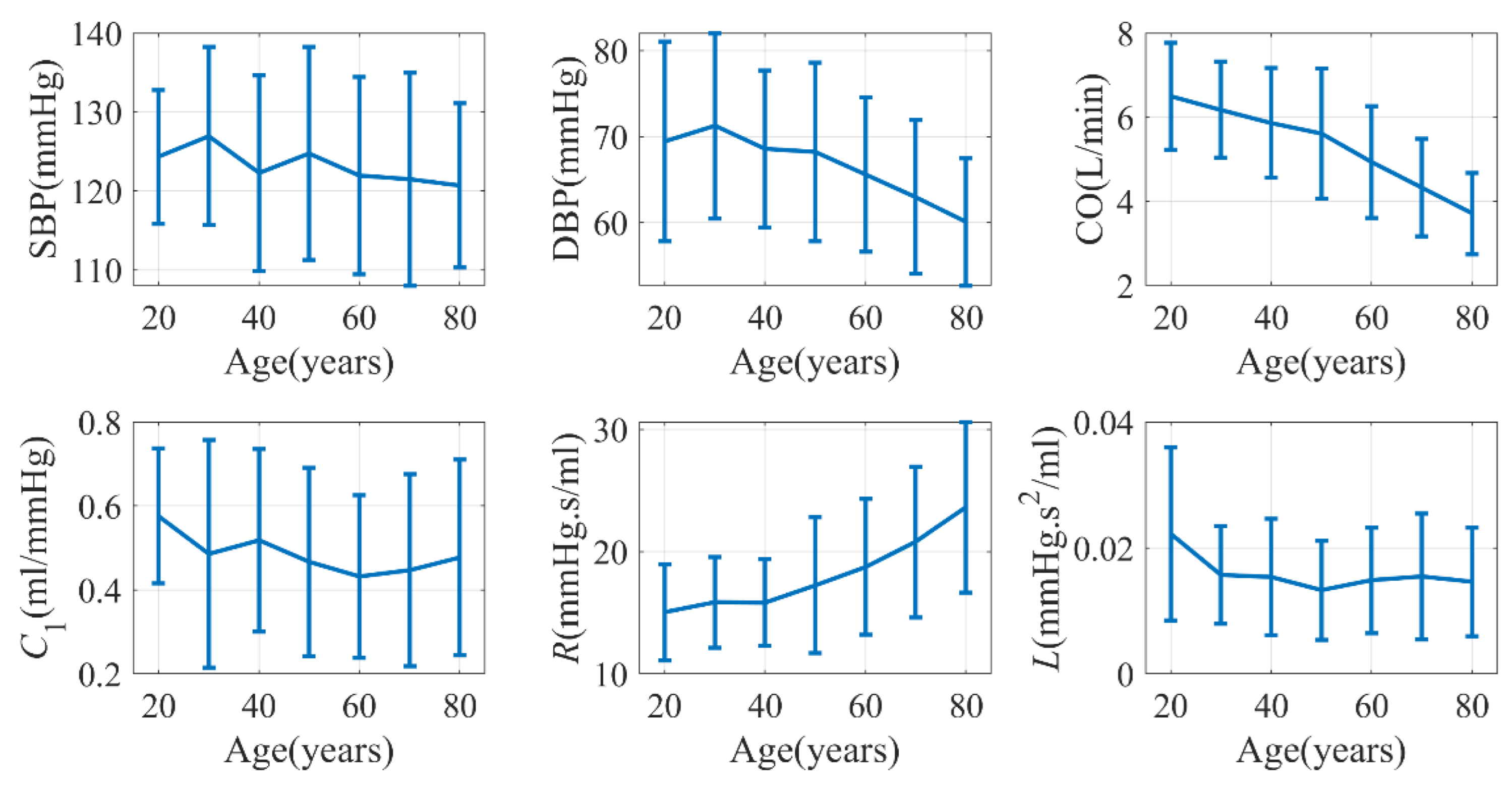
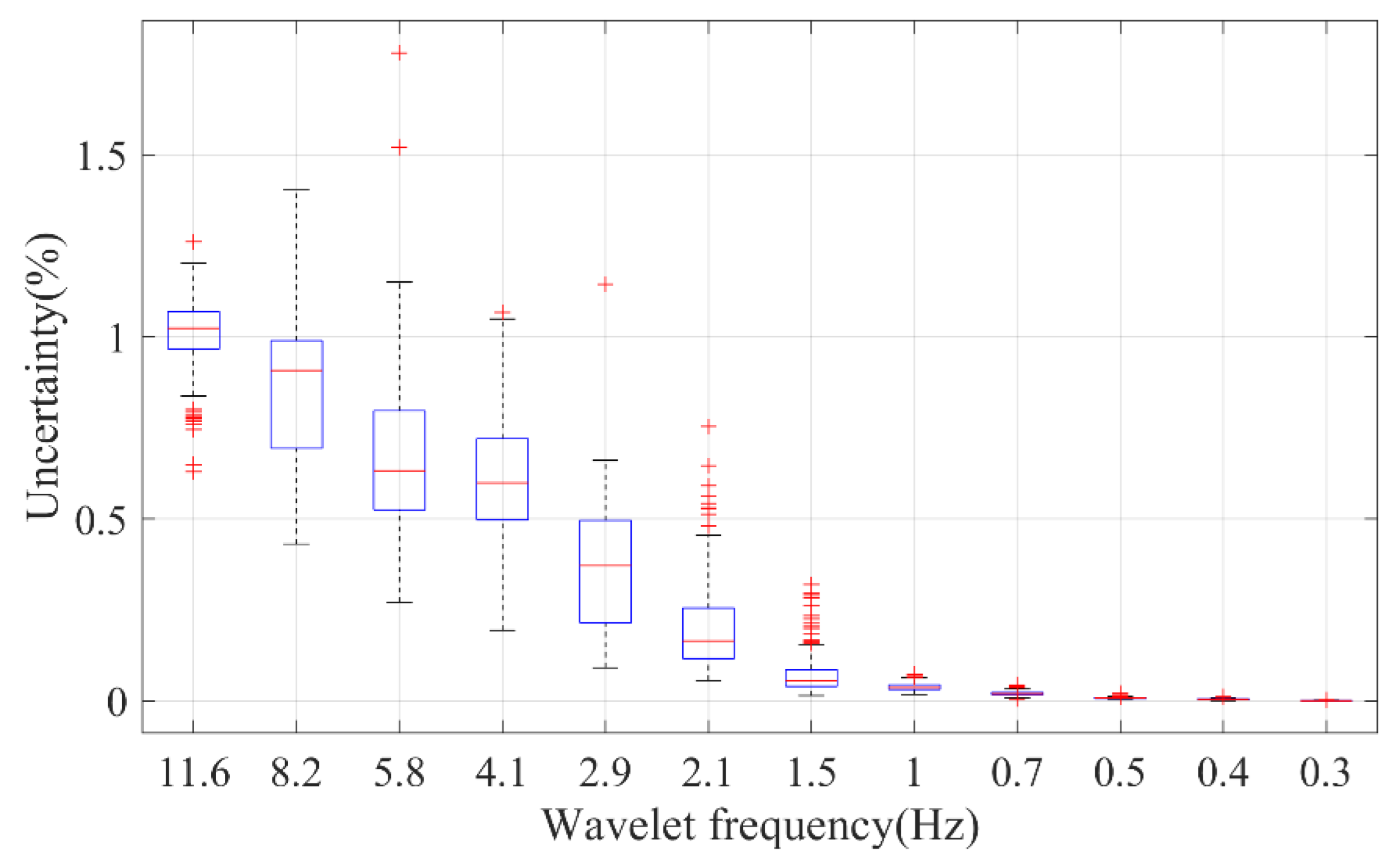

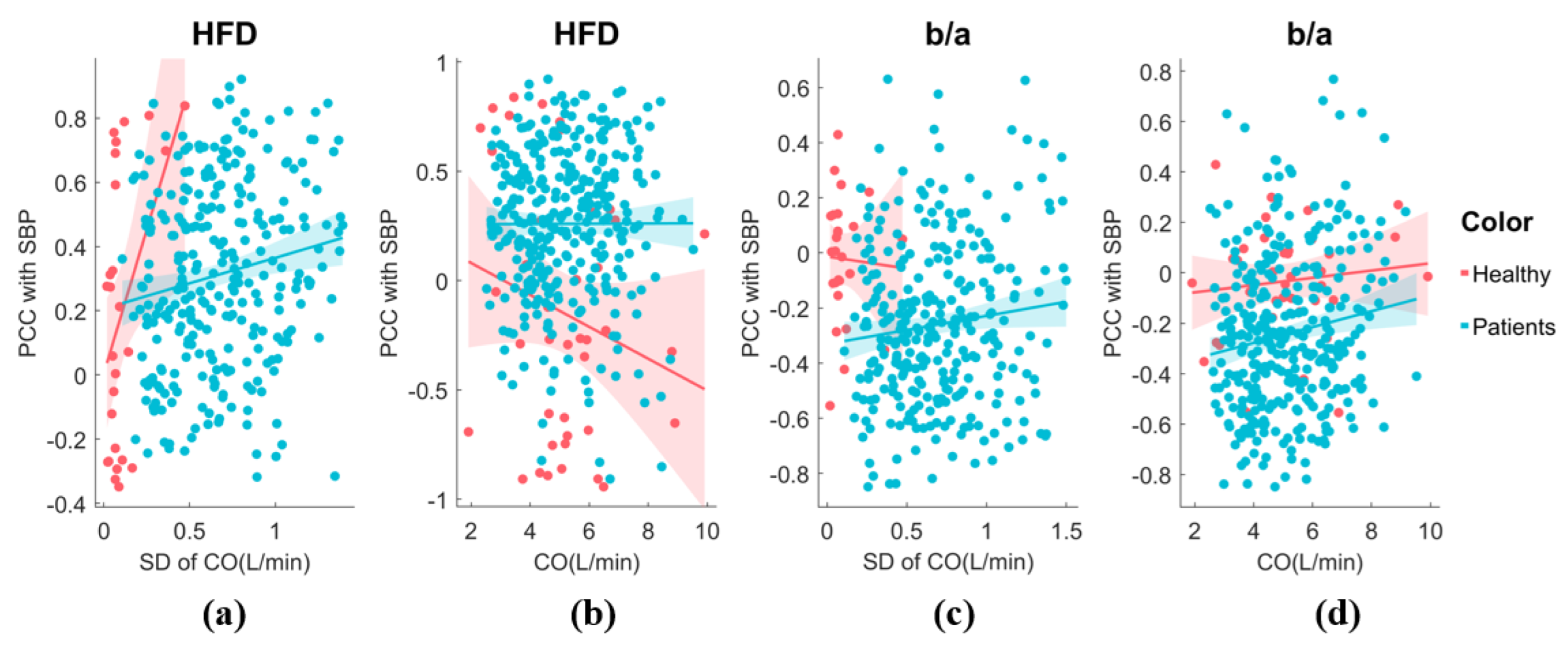

| VitalDB | Healthy | |||
|---|---|---|---|---|
| Mean ± STD | Range | Mean ± STD | Range | |
| Age (years) | 55.5 ± 14.9 | 20–82 | 33.9 ± 14.5 | 18–65 |
| Height (cm) | 163.9 ± 8.4 | 147–183 | 171.1 ± 10.7 | 148–198 |
| Weight (kg) | 62.2 ± 11.1 | 41–89 | 76.0 ± 17.6 | 48–136 |
| SBP (mmHg) | 122.3 ± 18.6 | 84–168 | 146 ± 25 | 80–193 |
| DBP (mmHg) | 66.1 ± 12.8 | 41–98 | 88 ± 18 | 43–109 |
| Features | Definition |
|---|---|
| AC | Pulsating amplitude of PPG [33] |
| DC | Mean of PPG baseline [33] |
| AREA | Area under the normalized PPG waveform [34] |
| SPMEAN | Mean upstroke slope during the systolic period [35] |
| SPVAR | Variation of upstroke slope (standard deviation) during the systolic period [36] |
| DPMEAN | Mean downstroke slope during the diastolic period [35] |
| DPVAR | Variation of downstroke slope (standard deviation) during the diastolic period [35] |
| b/a | Height of the early negative peak over the early positive peak of second derivatives of PPG [37] |
| Correlation between the Percentage Power of Wavelet Fractal Components and C1 | |||||||
|---|---|---|---|---|---|---|---|
| Wavelet frequency (Hz) | 11.63 | 8.23 | 5.82 | 4.11 | 2.91 | 2.06 | 1.45 |
| PCC | 0.01 | −0.44 * | −0.34 * | −0.32 * | −0.21 | −0.19 | −0.13 |
| HFD | KFD | LF/HF | AC | b/a | |
|---|---|---|---|---|---|
| Unidirectional hemodynamics-caused complexity | 195 | 74 | 23 | 95 | 192 |
| Unidirectional complexity caused hemodynamic changes | 62 | 60 | 276 | 151 | 35 |
| Bidirectional feedback | 74 | 54 | 20 | 82 | 115 |
| No causality | 70 | 213 | 82 | 73 | 59 |
| Studies | Algorithm | MAE (mmHg) | Data Source | |
|---|---|---|---|---|
| SBP | DBP | |||
| Radha et al. [2] | LSTM | 8.22 (RMSE) | 6.55 (RMSE) | 106 healthy subjects |
| Harfiya et al. [57] | LSTM | 4.05 | 2.41 | MIMIC dataset |
| Slapničar et al. [59] | Spectro-Temporal Deep Neural Network | 9.43 | 6.88 | MIMIC dataset |
| Wang et al. [58] | LASSO-LSTM | 4.95 6.14 | 3.15 5.61 | UCI-ML-BP; MPC-FAHUSTC dataset |
| Atef et al. [60] | LSTM with multistage transfer learning | 2.03 | 1.18 | MIMIC dataset |
| Meng et al. [61] | DC-Bi-RNN | 3.21 | 1.80 | MIMIC dataset |
Disclaimer/Publisher’s Note: The statements, opinions and data contained in all publications are solely those of the individual author(s) and contributor(s) and not of MDPI and/or the editor(s). MDPI and/or the editor(s) disclaim responsibility for any injury to people or property resulting from any ideas, methods, instructions or products referred to in the content. |
© 2023 by the authors. Licensee MDPI, Basel, Switzerland. This article is an open access article distributed under the terms and conditions of the Creative Commons Attribution (CC BY) license (https://creativecommons.org/licenses/by/4.0/).
Share and Cite
Xing, X.; Dong, W.-F.; Xiao, R.; Song, M.; Jiang, C. Analysis of the Chaotic Component of Photoplethysmography and Its Association with Hemodynamic Parameters. Entropy 2023, 25, 1582. https://doi.org/10.3390/e25121582
Xing X, Dong W-F, Xiao R, Song M, Jiang C. Analysis of the Chaotic Component of Photoplethysmography and Its Association with Hemodynamic Parameters. Entropy. 2023; 25(12):1582. https://doi.org/10.3390/e25121582
Chicago/Turabian StyleXing, Xiaoman, Wen-Fei Dong, Renjie Xiao, Mingxuan Song, and Chenyu Jiang. 2023. "Analysis of the Chaotic Component of Photoplethysmography and Its Association with Hemodynamic Parameters" Entropy 25, no. 12: 1582. https://doi.org/10.3390/e25121582
APA StyleXing, X., Dong, W.-F., Xiao, R., Song, M., & Jiang, C. (2023). Analysis of the Chaotic Component of Photoplethysmography and Its Association with Hemodynamic Parameters. Entropy, 25(12), 1582. https://doi.org/10.3390/e25121582







